The expansion valve market is set to grow from USD 12.0 billion in 2025 to USD 18.1 billion by 2035, adding USD 6.0 billion in new revenue and advancing at a CAGR of 4.2%. This growth is driven by increasing global demand for energy-efficient HVAC systems, growing urbanization, and rising adoption of advanced refrigeration technologies. Thermal Expansion Valves (TXV) will dominate with 70.0% market share, favored for their proven reliability and cost-effectiveness in HVAC and refrigeration applications. The air conditioning application segment will lead with 60.0% market share, driven by demand for climate control solutions in residential, commercial, and industrial buildings.
The market is divided by product type, with thermal expansion valves (TXV) holding the largest share. The air conditioning segment leads application-wise, followed by refrigeration. By refrigerant, R410A and R134A are key types. The market is witnessing a shift toward electronic expansion valves (EXV), with growing demand for smart HVAC systems and IoT integration. Asia Pacific leads growth, with China and India showing the highest CAGRs at 6.8% and 6.5%, respectively, driven by urbanization and increasing construction activity. Developed regions like the USA, Germany, and France prioritize energy efficiency, compliance, and environmental standards.
One of the primary drivers of growth in the expansion valve market is the increasing demand for refrigeration and air conditioning systems worldwide. The global rise in temperatures, particularly in developing regions, combined with urbanization and the growing adoption of consumer goods that require climate control, is driving the demand for HVAC systems. Expansion valves are a key part of refrigeration and air conditioning systems, where they regulate the flow of refrigerant into the evaporator coils, ensuring efficient cooling and maintaining desired temperatures. As the HVAC market continues to grow, especially with the increasing demand for energy-efficient systems and green technologies, the need for advanced expansion valves is expected to rise.
Expansion valves are often made from durable materials such as brass and stainless steel, and fluctuations in the prices of these materials can affect the overall cost structure. Additionally, as industries move toward adopting more advanced technologies, the complexity of valve systems increases, requiring manufacturers to invest in research and development to meet changing market demands. The growing regulatory pressures related to refrigerants, such as the phase-out of high-GWP refrigerants, also present challenges for manufacturers, who need to develop valves compatible with low-GWP, eco-friendly refrigerants.
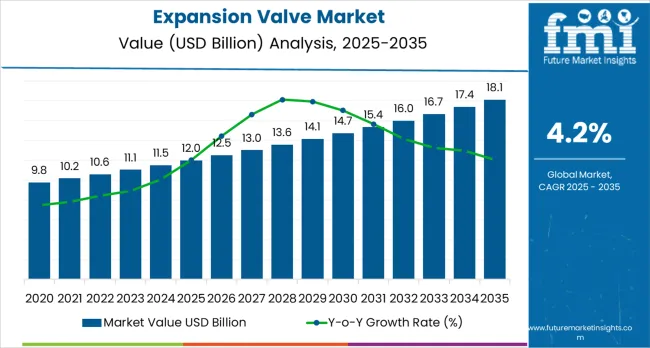
| Metric | Value |
|---|---|
| Estimated Value in (2025E) | USD 12.0 billion |
| Forecast Value in (2035F) | USD 18.1 billion |
| Forecast CAGR (2025 to 2035) | 4.2% |
Market expansion is being supported by the increasing global demand for energy-efficient cooling systems and the corresponding need for precision flow control equipment that can maintain operational reliability and temperature control standards while supporting diverse HVAC and refrigeration applications across various building environments. Modern commercial buildings and residential facilities are increasingly focused on implementing valve solutions that can reduce energy consumption, minimize maintenance requirements, and provide consistent performance in climate control operations. Expansion valves'proven ability to deliver enhanced cooling efficiency, reliable refrigerant flow capabilities, and versatile HVAC applications make them essential equipment for contemporary building operations and climate control solutions.
The growing emphasis on environmental compliance and energy efficiency is driving demand for expansion valves that can support advanced HVAC systems, reduce operational costs, and enable efficient temperature control across varying cooling load conditions. Building operators'preference for equipment that combines precision control with energy efficiency and cost-effectiveness is creating opportunities for innovative valve implementations. The rising influence of smart building technologies and automated climate control systems is also contributing to increased adoption of expansion valves that can provide advanced operational control without compromising performance or environmental standards.
The expansion valve market is poised for robust growth and transformation. As building operators and HVAC system integrators across both developed and emerging markets seek flow control equipment that is efficient, reliable, precise, and environmentally compliant, expansion valve systems are gaining prominence not just as mechanical components but as strategic infrastructure for operational efficiency, energy management, temperature control optimization, and environmental compliance.
Rising HVAC demands and building modernization in Asia Pacific, North America, and Europe amplify demand, while manufacturers are picking up on innovations in electronic technologies and smart monitoring systems.
Pathways like electronic valve adoption, IoT integration, and smart building connectivity promise strong margin uplift, especially in developed markets. Geographic expansion and application diversification will capture volume, particularly where HVAC infrastructure requires modernization. Environmental pressures around energy efficiency, refrigerant management, operational reliability, and emission reduction give structural support.
The market is segmented by product type, application, installation, type, material type, refrigerant, working pressure, and region. By product type, the market is divided into thermal expansion valves (TXV) and electronic expansion valves (EXV). By application, it is segmented into air conditioning and refrigeration. By installation, it covers new sales and retrofit applications. By type, it includes automotive (OEM and aftermarket), industrial facilities, commercial buildings, retail outlets &warehousing, and residential. By material type, it is categorized into stainless steel, copper, brass, and others. By refrigerant, it covers R410A, R407C, R404A, R134A, R290, R744, R22, CO2, Glycol Water, and R1234YF. By working pressure, it includes up to 30 bar, 30 to 50 bar, and 50 to 200 bar. Regionally, the market is divided into North America, Latin America, Western Europe, Eastern Europe, East Asia, South Asia Pacific, and Middle East &Africa.
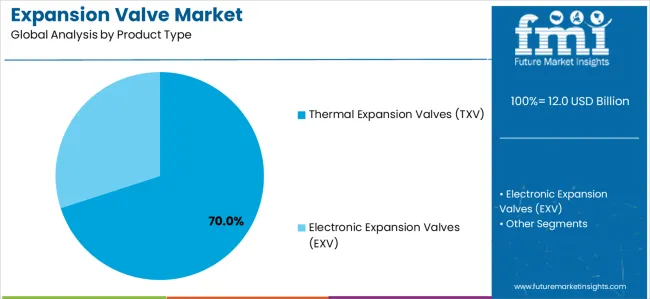
The thermal expansion valves segment is projected to account for 70.0% of the expansion valve market in 2025, reaffirming its position as the leading product category. HVAC system operators and building managers increasingly utilize thermal expansion valves for their proven reliability, established cost-effectiveness, and consistent performance in refrigerant flow control across air conditioning, refrigeration, and commercial cooling applications. Thermal expansion valve technology's established operational procedures and mechanical simplicity directly address the HVAC requirements for reliable temperature control and operational efficiency in diverse building environments.
This product segment forms the foundation of current HVAC operations, as it represents the technology with the greatest operational reliability and established maintenance infrastructure across multiple applications and cooling scenarios. Operator investments in enhanced thermal valve systems and performance optimization continue to strengthen adoption among building operators and HVAC contractors. With operators prioritizing operational reliability and cost management, thermal expansion valves align with both performance objectives and budget requirements, making them the central component of comprehensive HVAC system strategies.

Air conditioning application is projected to represent 60.0% of expansion valve demand in 2025, underscoring its critical role as the primary application for building climate control and commercial cooling operations. Building operators prefer expansion valves for their efficiency, reliability, and ability to handle variable cooling loads while supporting comfort requirements and energy management objectives. Positioned as essential components for modern air conditioning systems, expansion valves offer both operational advantages and energy benefits.
The segment is supported by continuous innovation in building climate control expansion and the growing availability of specialized valve configurations that enable efficient cooling with enhanced temperature control capabilities. Additionally, commercial buildings are investing in air conditioning optimization to support large-scale operations and occupant comfort delivery. As building cooling becomes more prevalent and energy efficiency requirements increase, air conditioning applications will continue to dominate the application market while supporting advanced valve utilization and building management strategies.
The expansion valve market is advancing steadily due to increasing demand for energy-efficient HVAC systems and growing adoption of advanced climate control infrastructure that provides enhanced cooling capabilities and temperature control reliability across diverse commercial and residential applications. However, the market faces challenges, including high initial investment costs for electronic valves, specialized installation requirements, and varying operational requirements across different HVAC system configurations. Innovation in electronic technologies and smart monitoring systems continues to influence valve development and market expansion patterns.
The growing expansion of urban construction and HVAC infrastructure development is enabling valve manufacturers to develop expansion valve systems that provide superior cooling efficiency, enhanced temperature control capabilities, and reliable performance in high-demand climate control environments. Advanced expansion valve systems provide improved operational capacity while allowing more effective refrigerant management and consistent cooling delivery across various applications and building requirements. Manufacturers are increasingly recognizing the competitive advantages of modern valve capabilities for operational efficiency and HVAC system positioning.
Modern expansion valve manufacturers are incorporating electronic control systems and automated monitoring technologies to enhance operational precision, reduce energy consumption, and ensure consistent temperature control delivery to HVAC operators. These technologies improve system efficiency while enabling new applications, including IoT connectivity and predictive maintenance monitoring solutions. Advanced technology integration also allows manufacturers to support premium valve positioning and performance optimization beyond traditional mechanical valve supply.
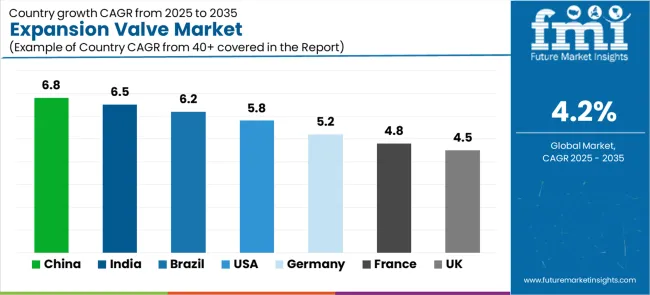
| Country | CAGR (2025-2035) |
|---|---|
| China | 6.8% |
| India | 6.5% |
| Brazil | 6.2% |
| USA | 5.8% |
| Germany | 5.2% |
| France | 4.8% |
| United Kingdom | 4.5% |
The expansion valve market is experiencing steady growth globally, with China leading at a 6.8% CAGR through 2035, driven by massive urbanization programs, extensive HVAC infrastructure development, and significant adoption of air conditioning systems supported by industrial expansion and residential construction activities. India follows at 6.5%, supported by rapid economic development, growing middle-class purchasing power, and increasing adoption of cooling technologies. Brazil shows growth at 6.2%, emphasizing infrastructure development and commercial construction expansion. USA demonstrates 5.8% growth, driven by building modernization and energy efficiency initiatives. Germany records 5.2%, focusing on environmental compliance and smart building technologies. France demonstrates 4.8% growth, supported by commercial building upgrades and regulatory requirements. United Kingdom shows 4.5% growth, driven by building efficiency standards but constrained by mature market conditions.
The report covers an in-depth analysis of 40+ countries;seven top-performing countries are highlighted below.
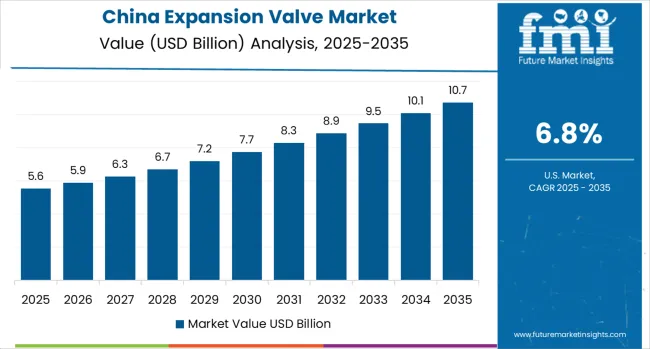
Revenue from expansion valves in China is projected to exhibit exceptional growth with a CAGR of 6.8% through 2035, driven by massive urbanization programs and extensive HVAC infrastructure development supported by industrial expansion and residential construction activities. The country's comprehensive building development strategy and increasing demand for air conditioning systems are creating substantial demand for advanced valve solutions. Major construction companies and HVAC manufacturers are establishing extensive equipment operations to address the growing demand for efficient cooling and temperature control.
Revenue from expansion valves in the USA is expanding at a CAGR of 5.8%, supported by building infrastructure modernization programs and growing adoption of energy-efficient HVAC solutions supported by environmental regulations and operational efficiency initiatives. The country's established building infrastructure and increasing investment in smart technologies are creating demand for advanced valve solutions. Major facilities and commercial buildings are establishing comprehensive equipment systems to serve both operational requirements and regulatory compliance.
Revenue from expansion valves in India is expanding at a CAGR of 6.5%, supported by the country's rapid economic development, growing urbanization, and increasing adoption of air conditioning systems. The country's expanding middle class and rising disposable incomes are driving sophisticated cooling capabilities. Commercial buildings and residential developments are establishing extensive HVAC operations to address the growing demand for efficient temperature control and comfort systems.
Revenue from expansion valves in Brazil is expanding at a CAGR of 6.2%, supported by the country's infrastructure development programs, growing commercial construction, and increasing investment in HVAC modernization. Brazil's expanding commercial sector and emphasis on building development are driving demand for reliable valve technologies across major urban markets. Construction companies and building operators are establishing equipment partnerships to serve both domestic development needs and commercial building requirements.
Revenue from expansion valves in Germany is expanding at a CAGR of 5.2%, supported by the country's strong environmental regulations, advanced engineering capabilities, and comprehensive building efficiency programs among commercial operators. The nation's mature HVAC sector and increasing emphasis on energy efficiency are driving sophisticated valve capabilities throughout the equipment market. Leading building operators and manufacturers are investing extensively in valve technology development and system integration to serve both domestic building needs and export markets.
Revenue from expansion valves in France is expanding at a CAGR of 4.8%, supported by the country's focus on commercial building modernization, comprehensive environmental compliance programs, and strategic investment in HVAC efficiency improvement. France's established construction industry and emphasis on building performance are driving demand for specialized valve technologies focusing on operational reliability and energy efficiency. Building operators are investing in comprehensive equipment modernization to serve both domestic construction requirements and regulatory compliance objectives.
Revenue from expansion valves in the United Kingdom is expanding at a CAGR of 4.5%, supported by the country's building efficiency regulations, increasing operational optimization requirements, and growing investment in HVAC modernization. The country's established building infrastructure and emphasis on energy compliance are supporting demand for advanced valve technologies across major commercial markets. Building operators and facility managers are establishing equipment programs to serve both domestic building needs and operational efficiency requirements.
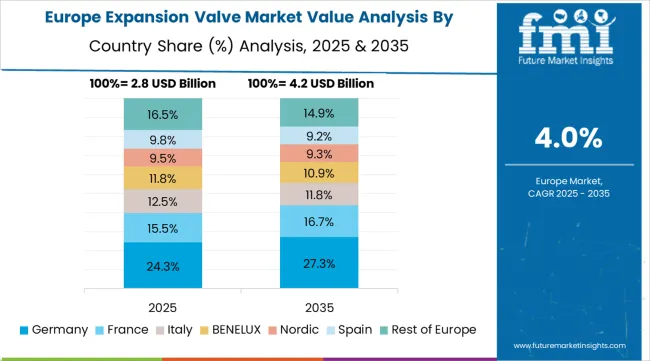
The expansion valve market in Europe is projected to grow from USD 3.2 billion in 2025 to USD 4.8 billion by 2035, registering a CAGR of 4.1% over the forecast period. Germany is expected to maintain its leadership position with a 28.5% market share in 2025, increasing to 29.1% by 2035, supported by its advanced engineering capabilities, comprehensive environmental regulations, and major HVAC installations serving European and international markets.
France follows with a 19.2% share in 2025, projected to ease to 18.8% by 2035, driven by commercial building modernization programs, environmental compliance initiatives, and established construction capabilities, but facing challenges from competitive pressures and market maturity constraints. United Kingdom holds a 16.7% share in 2025, expected to decline to 16.3% by 2035, supported by building efficiency requirements and operational optimization initiatives but facing challenges from economic uncertainties. Italy commands a 13.8% share in 2025, projected to reach 14.0% by 2035, while Spain accounts for 11.2% in 2025, expected to reach 11.4% by 2035. The Rest of Europe region, including Nordic countries, Eastern European markets, Netherlands, Belgium, and other European countries, is anticipated to maintain momentum, with its collective share remaining stable from 10.6% to 10.4% by 2035, attributed to steady HVAC development across Nordic countries and consistent building modernization across various European markets implementing efficiency upgrade programs.
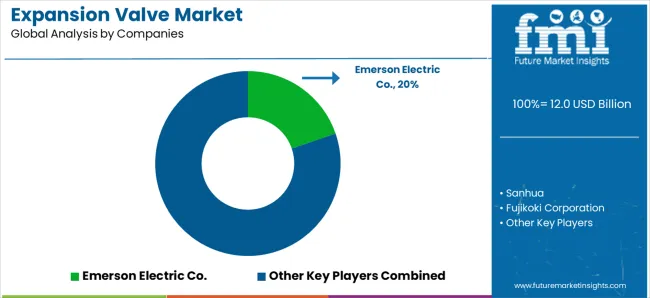
The expansion valve market is characterized by 10–15 major players, with the top five companies holding around 55–60% of the global market share, driven by their advanced technology, reliability, and strong customer relationships in the HVAC, refrigeration, and automotive industries. Competition centers on valve performance, energy efficiency, durability, and product customization, rather than price alone. Emerson Electric Co. leads the market with an 20% share, supported by its wide range of high-performance expansion valves, global manufacturing capabilities, and strong presence in commercial refrigeration and HVAC systems.
Market leaders such as Emerson Electric Co., Sanhua, Fujikoki Corporation, and OTTO EGELHOF GmbH & Co. KG maintain their positions through their ability to provide highly reliable, energy-efficient, and customizable expansion valve solutions for a wide array of applications. These companies leverage their extensive R&D capabilities, product innovation, and deep customer relationships across industries like HVAC, refrigeration, and automotive air conditioning.
Challengers including Castel S.r.l., TGK CO., LTD., and CAREL INDUSTRIES S.p.A. differentiate themselves by offering tailored expansion valve solutions for niche applications, such as industrial cooling and advanced air conditioning systems. Smaller players like Parker-Hannifin Corporation, Denso, and Hanon Systems focus on automotive and specialized systems, offering competitive pricing and flexible solutions to cater to specific regional and industry requirements, further intensifying market competition.
| Items | Values |
|---|---|
| Quantitative Units (2025) | USD 12 billion |
| Product Type | Thermal Expansion Valves (TXV), Electronic Expansion Valves (EXV) |
| Application | Air Conditioning, Refrigeration |
| Installation | New Sales, Retrofit |
| End User | Automotive (OEM &Aftermarket), Industrial Facilities, Commercial Buildings, Retail Outlets and Warehousing, Residential |
| Material Type | Stainless Steel, Copper, Brass, Others |
| Refrigerant Type | R410A, R407C, R404A, R134A, R290, R744, R22, CO2, Glycol Water, R1234YF |
| Working Pressure | Up to 30 bar, 30 to 50 bar, 50 to 200 bar |
| Regions Covered | North America, Latin America, Western Europe, Eastern Europe, East Asia, South Asia Pacific, Middle East &Africa |
| Countries Covered | United States, Canada, Germany, United Kingdom, France, China, Japan, Brazil, India and 40+ countries |
| Key Companies Profiled | Emerson Electric Co., Sanhua, Fujikoki Corporation, OTTO EGELHOF GmbH & Co. KG, Castel S.r.l., TGK CO., LTD., CAREL INDUSTRIES S.p.A., Parker-Hannifin Corporation, Denso, and Hanon Systems |
| Additional Attributes | Valve sales by product type and application, regional demand trends, competitive landscape, technological advancements in electronic systems, smart monitoring development, IoT integration innovation, and operational efficiency optimization |
The global expansion valve market is estimated to be valued at USD 12.0 billion in 2025.
The market size for the expansion valve market is projected to reach USD 18.1 billion by 2035.
The expansion valve market is expected to grow at a 4.2% CAGR between 2025 and 2035.
The key product types in expansion valve market are thermal expansion valves (txv) and electronic expansion valves (exv).
In terms of application, air conditioning segment to command 60.0% share in the expansion valve market in 2025.






Our Research Products

The "Full Research Suite" delivers actionable market intel, deep dives on markets or technologies, so clients act faster, cut risk, and unlock growth.

The Leaderboard benchmarks and ranks top vendors, classifying them as Established Leaders, Leading Challengers, or Disruptors & Challengers.

Locates where complements amplify value and substitutes erode it, forecasting net impact by horizon

We deliver granular, decision-grade intel: market sizing, 5-year forecasts, pricing, adoption, usage, revenue, and operational KPIs—plus competitor tracking, regulation, and value chains—across 60 countries broadly.

Spot the shifts before they hit your P&L. We track inflection points, adoption curves, pricing moves, and ecosystem plays to show where demand is heading, why it is changing, and what to do next across high-growth markets and disruptive tech

Real-time reads of user behavior. We track shifting priorities, perceptions of today’s and next-gen services, and provider experience, then pace how fast tech moves from trial to adoption, blending buyer, consumer, and channel inputs with social signals (#WhySwitch, #UX).

Partner with our analyst team to build a custom report designed around your business priorities. From analysing market trends to assessing competitors or crafting bespoke datasets, we tailor insights to your needs.
Supplier Intelligence
Discovery & Profiling
Capacity & Footprint
Performance & Risk
Compliance & Governance
Commercial Readiness
Who Supplies Whom
Scorecards & Shortlists
Playbooks & Docs
Category Intelligence
Definition & Scope
Demand & Use Cases
Cost Drivers
Market Structure
Supply Chain Map
Trade & Policy
Operating Norms
Deliverables
Buyer Intelligence
Account Basics
Spend & Scope
Procurement Model
Vendor Requirements
Terms & Policies
Entry Strategy
Pain Points & Triggers
Outputs
Pricing Analysis
Benchmarks
Trends
Should-Cost
Indexation
Landed Cost
Commercial Terms
Deliverables
Brand Analysis
Positioning & Value Prop
Share & Presence
Customer Evidence
Go-to-Market
Digital & Reputation
Compliance & Trust
KPIs & Gaps
Outputs
Full Research Suite comprises of:
Market outlook & trends analysis
Interviews & case studies
Strategic recommendations
Vendor profiles & capabilities analysis
5-year forecasts
8 regions and 60+ country-level data splits
Market segment data splits
12 months of continuous data updates
DELIVERED AS:
PDF EXCEL ONLINE
Electronic Expansion Valves Market Size and Share Forecast Outlook 2025 to 2035
Valve Grinder Market Size and Share Forecast Outlook 2025 to 2035
Valve Seat Inserts Market Size and Share Forecast Outlook 2025 to 2035
Valve Driver Market Size and Share Forecast Outlook 2025 to 2035
Valve Remote Control Systems Market Analysis by Type, Application and Region - Forecast for 2025 to 2035
Valve Positioner Market Growth – Trends & Forecast (2024-2034)
Valve Cover Gasket Market
Valve Sack Market
ESD Valve Market Forecast and Outlook 2025 to 2035
EGR Valve Market
HVAC Valve Market Size and Share Forecast Outlook 2025 to 2035
Flat Valve Caps And Closures Market Size and Share Forecast Outlook 2025 to 2035
Gate Valve Market Growth – Trends & Forecast 2023-2033
Korea Valve Seat Insert Market Trend Analysis Based on Sales, Material, Engine, End-Use, and Provinces 2025 to 2035
Japan Valve Seat Inserts Market Trend Analysis Based on Sales Channel, Material, Engine, End-Use and Provinces 2025 to 2035
Lined Valve Market Growth – Trends & Forecast 2024-2034
Remote Valve Tissue Expanders Market Size and Share Forecast Outlook 2025 to 2035
Bag On Valve Product Market Size and Share Forecast Outlook 2025 to 2035
Engine Valve Market Size and Share Forecast Outlook 2025 to 2035
Pasted Valve Bags Market Size and Share Forecast Outlook 2025 to 2035

Thank you!
You will receive an email from our Business Development Manager. Please be sure to check your SPAM/JUNK folder too.
Chat With
MaRIA